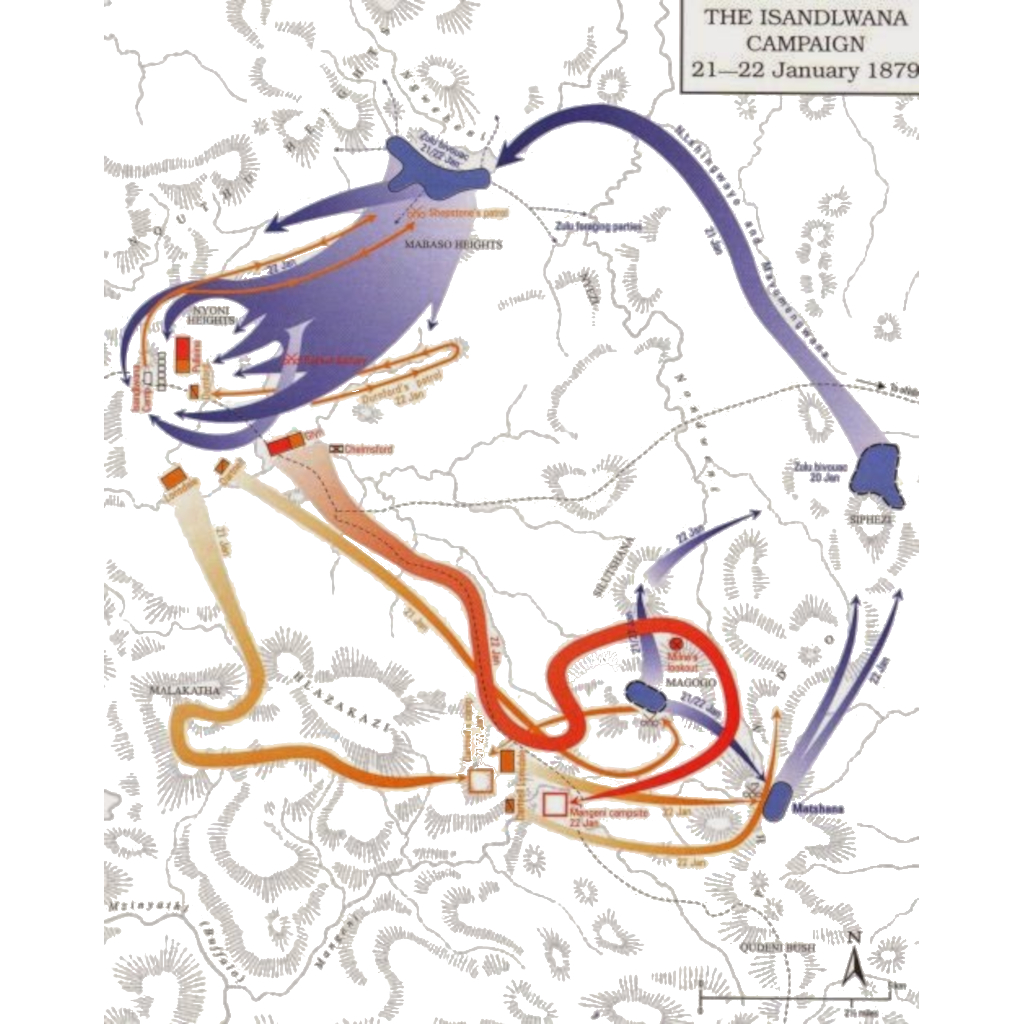The Battle of Isandlwana occurred on 22nd January 1879, during the Anglo-Zulu War. It was the first major encounter between the British Empire and the Zulu Kingdom, resulting in a decisive Zulu victory.
The British forces, led by Lord Chelmsford, invaded Zululand with a force of approximately 1,800 troops, including British regulars, colonial troops, and native auxiliaries. They established a camp at Isandlwana Hill, a location chosen for its strategic position. However, the camp was not fortified, leaving the British vulnerable to attack.
The Zulu army, consisting of around 20,000 warriors under the command of Ntshingwayo kaMahole and Dabulamanzi kaMpande, launched a surprise attack on the British camp. The Zulus, armed mainly with traditional weapons like assegai spears and cow-hide shields, but also some muskets, overwhelmed the British forces.
The battle began in the morning and lasted for several hours. Despite the British troops’ use of modern Martini-Henry rifles and artillery, they were unable to withstand the sheer numbers of the Zulu warriors. The British suffered heavy casualties, with over 1,300 killed, including 52 officers and 727 British regulars. The Zulu casualties were estimated to be between 1,000 and 3,000 killed.
The Battle of Isandlwana was a significant defeat for the British and marked the first time a modern European army had been defeated by an indigenous force equipped with inferior technology. The battle had a profound impact on British military tactics and led to a more aggressive approach in the subsequent phases of the Anglo-Zulu War.
Orders of Battle
British Orders of Battle
- British Commander-in-chief
- No. 2 Column (detachment), Brev Col A.W. Durnford, RE, commanding
- No. 11 Battery, 7th Brigade, RA 3 x 9 pounder rockets, Major F.B. Russell
- Natal Native Horse, Capt G. Barrington
- No. 1 Troop Sikali’s Horse Lt C. Raw
- No. 2 Troop Sikali’s Horse Lt J.A. Roberts
- No. 3 Troop Sikali’s Horse Lt R.W. Vause
- Endendale Troop, Lt H.D. Davies
- Hlubi’s Troop, Lt A.F. Henderson
- 1st/1st Natal Native Contingent
- D company Capt C. Nourse
- E company Capt W.R. Stafford
- No. 3 Column (detachment), Colonel H.B. Pulleine
- N Battery, 5th Brigade RA 2 x 7 pounder guns, Major S. Smith
- 5th Field Company, Royal Engineers
- A company 1st/24th Regiment of Foot, Lt C.W. Cavaye
- C company 1st/24th Regiment of Foot, Capt R. Younghusband
- E company 1st/24th Regiment of Foot, Lt F.P. Porteous
- F company 1st/24th Regiment of Foot, Capt W.E. Mostyn
- G company 2st/24th Regiment of Foot, Lt C.D.A. Pope
- H company 1st/24th Regiment of Foot, Capt G.V. Wardell
- No. 1 Squadron mounted Infantry
- Natal Mounted Police
- Natal Volunteers Corps, Major Dartnell
- Natal Carabineers Lt F.J.D. Scott
- Newcastle Mounted Rifles Capt C.R. Bradstreet
- Buffalo Border Guard
- 1st/3rd Natal Native Contingent
- No. 6 company Capt R. Krohn
- No. 9 company Capt J.F Lonsdale
- 2nd/3rd Natal Native Contingent
- No. 4 company Capt E. Erskine
- No. 5 company Capt A.J. Barry
- Natal Native Pioneers Corps
- No. 1 company
- Army Service Corps 90th Regiment of Foot
- Army Hospital Corps
- Army Medical Department
Zulu Orders of Battle
- Zulu Commander-in-chief
- Ntshingwayo kaMahole
- Mavumengwana kaNdlela
- Prince Dabulamanzi kaMapande
- Left Horn Regiments
- inGobamakhosi
- uMbonambi
- uVe
- Chest Regiments
- umKhulutshane
- umHlanga
- isAngqu
- umCijo
- Right Horn Regiments
- uDududu
- uNokhenke
- iMbube
- Loins at Isandlwana Reserve Regiments that were sent to Rorke’s Drift
- uThulwana
- uDloko
- inDluyengwe
- inDlondlo
Download This Scenario
How it Played
Sources
Other blog categories that may be of interest. 10mm ACW Project, 10mm AWI Project, 10mm AZW Project, 10mm CGW Project, 10mm FIW Project, 10mm Sci-Fi Projects, Aliens, Dropzone Commander, Terra Nova, 10mm WWI Project, 10mm WWII Project, 10mm Zombie Project, Battle Reports & Scenarios, Making Scenery & Terrain, Painting Guides, Shows & Events, Solo Wargaming, Wargaming Projects, Wargaming Rules.


Leave a Reply